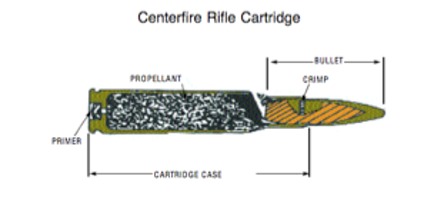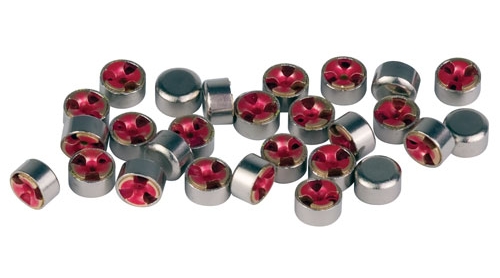Anatomy of a Cartridge
A Cartridge is a self contained casing that is composed of a bullet, propellant and a primer. Cartridges are the most common form of ammunition for most firearms today. Before the invention of cartridges, gunpowder was loaded directly into the chamber of the gun, followed by a wad and the bullet. The guns were usually charged through the muzzle end of the barrel. The charge was ignited using a percussion cap that was struck by and external hammer. These guns are called muzzleloaders, and are still are available today. Now with today’s modern conveniences, most all of the guns built and sold are guns that fire the modern cartridges. The cartridge itself is usually made of brass. When combustion of the propellant takes place, the casing directs the energy of the expanding gases to the bullet. Before the design of the modern cartridges, reloading a rifle took much longer and did not give as high of reliability and consistency.

The cases are manufactured to standards to match dimensions of various
commercially produced cartridges. There are hundreds of different
cartridges
available on the market. Each cartridge has its best uses, based on
bullet
caliber (diameter), case volume, neck angle, length, primer type, rim
design.
The biggest determinate for selecting a cartridge is overall power of
the
cartridge. Based on the game that is to be hunted, one may consider a
cartridge
for its muzzle energy, velocity, ability to shoot accurately. Many
cartridges
were developed by arms manufacturers that built the cartridges for use
in their
firearms. Some cartridges were developed experimentally by taking
existing
cartridges and making a modified or "Wildcat" cartridge from it. Many
"Wildcatters" improved upon cartridges that were already successful
designs.

There are many factors that determine a cartridges performance,
accuracy and
overall effectiveness. The volume of the case is the limiting factor of
the
size of charge that can be used to fire the bullet. The dimension of
the case
effects how the charge is ignited and burned. Since the propellant is
burned
inside the cartridge, a long narrow case will burn slower that a short
fat case
will.
Chemical Equation for Blackpowder Combustion
2 KNO3
+ S
+ 3 C
→ K2S + N2
+ 3 CO2
The propellant that is used for rifles has changed over the years, but still functions the same way. Prior to modern “smokeless” gunpowder, blackpowder was used. Black powder is made of three basic ingredients: charcoal (carbon), sulfur, and potassium nitrate. Black powder has been replaced with propellants that offer a much, much cleaner burn. These smokeless powders are mostly nitrocellulose based. These powders are available at different varieties to meet the best properties for a given application. Powders are chosen based on their properties of burn rate. For rifles they generally use a high energy, slow burning powder. Pistols use a lower energy faster burning powder, this is based on the time that it takes for the bullet to be fired and exit the barrel. There is an expansion of hot gases that takes place once the powder is ignited, and the burn rate must be matched to the firearm that it is to be used for. Many rifle shooters reload their own ammunition and use books that guide them in selecting powders for their particular load/ rifle.

Primers are a high energy ignition source used to ignite the charge. They are designed to be struck by a quick blow which causes a very hot flame to initiate the combustion of the propellant. This primer is located in the primer pocket which is at the rear of the cartridge. It transfers it's energy through the flash hole, which is a small passage that connects the primer pocket to the body of the cartridge. Primers use a highly sensitive high explosive. Primers are formed into as metal cap, on impact with the firing pin this detonates the small charge in the primer.

The bullets caliber determines the diameter of the bullet to be fired.
Calibers
are expressed as numbers such as .308" or 7.62mm. They are specific to
the
gun that is chambered for that round. The bullet weight is variable, as
there
are many bullet designs, available in different weights, based on uses
of the
bullet.
An important measure of a load combination is
the
velocity at which the bullet leaves the muzzle. This is called muzzle
velocity
it varies depending how much charge is used and weight of bullet. Many
manufacturers list the velocities, were it is an average muzzle
velocity but
will vary depending on the gun it is fired in. Another important number
to
consider is the muzzle energy; this is the kinetic energy of the
bullet, just
as it leaves the barrel. This energy will be a determining factor for
selecting
a cartridge/ load. This is the energy based on Kinetic energy equation.
Muzzle Energy (ME) = KE
=
½mv²
Home Page
How a rifle works Ballistics Propellants Accuracy
Bibliography